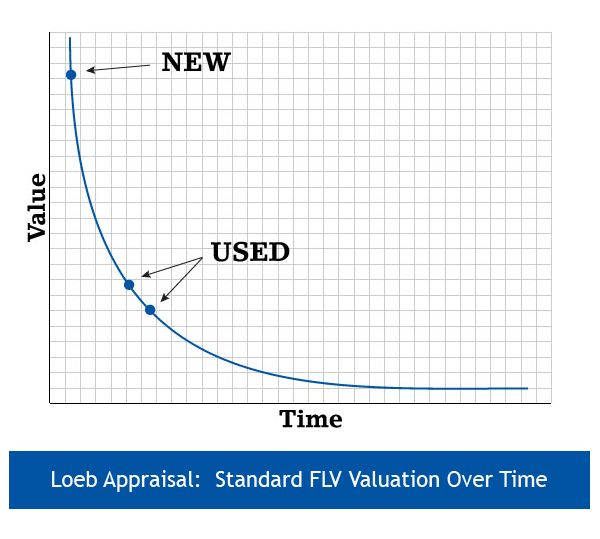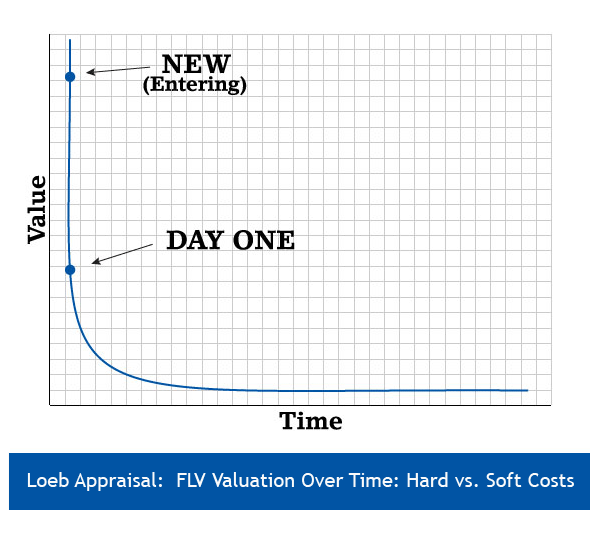Editor's Note: The charts in this blog posted earlier this month were inadvertently presented incorrectly. This error has now been rectified and Equipment Finance Advisor regrets the error.
Recently, when a group of lenders were discussing value trends, the following question was raised:
"From a collateral perspective, is it more secure to lend X percentage against used equipment than on new equipment because of there being less dissipation of value over time?"
In short, we at Loeb Appraisal would say yes to this line of thinking when the effect of the time element is fully considered.
Another lender in the room indicated he didn't follow, he stated:
"New equipment is new, therefore more valuable."
While his statement is true on day one, that can quickly change.

For example, a machine costs $100,000 brand new and its FLV at one year is $65,000. The lender advanced 100% of the new cost on a 5 year note. The outstanding loan value at the one year mark is approximately $85,000. The loan to value ratio is 1.31.
A machine costs $75,000 used and its FLV at one year is $65,000. The lender advanced 100% of the used cost on a five-year note. The outstanding loan value at the one year mark is approximately $63,000. The loan to value ratio is 0.97.
This is the reason that lenders who issue leases/loans on new equipment for three or five years recognize they are underwater from a value perspective for the first period of their loan. That is the “cash flow/ability to pay” component of the underwriting credit decision.
To further expand on this concept ... lenders will often advance on new equipment to cover both the “hard” equipment cost (actual cost of equipment) as well as the “soft” costs (engineering, installation, shipping, training etc.). Soft costs can be a noticeable percentage of an overall project.
A facility recently installed a fully automated/computerized conveyor system for a project cost of $4 million. The actual total cost for the recently installed system is a known value. However, the Forced Liquidation Value is quite a bit different. The soft costs play a large factor in the final valuation as these unrecoverable costs cannot be incorporated into a Forced Liquidation analysis. In this scenario the hard cost of the system was substantial but the value quickly dissipates as another user would have to spend quite a bit on soft costs to reconfigure for another use. Given that, there is significant value dissipation from an FLV opinion of value once installed.
In this example, it's important to consider the following: where is the lender entering the value curve? The lender has made the credit decision to advance the soft costs. The lender has made the credit decision to advance the hard costs. The day the system is fully installed and operational the sum total of $4 million has been spent. What is the FLV day one? There is no inherent value in the monies spent on soft costs from the FLV perspective. This is an immediate drop in the value curve straight down. Given it is a conveyor system the soft component is a large percentage of the total dollars spent. Anyone who would re-use this system from an FLV opinion of value would have to spend a large amount on soft costs again and therefore would not be willing to spend anywhere near the same on the hard costs from a used perspective. For that reason there is another immediate drop in the value curve before the curve even starts.

Certainly, both new equipment and used equipment can be secure collateral. The understanding needs to be in place that, when looking at the opinion of value curve, at what point is the lender joining the curve? The higher up the curve (meaning the newer or new equipment) will dissipate more value than a similar used unit that starts at a lower value. Also, soft costs immediately always come off the curve.
Understanding value today is critical and understanding where that value is going is just as critical.